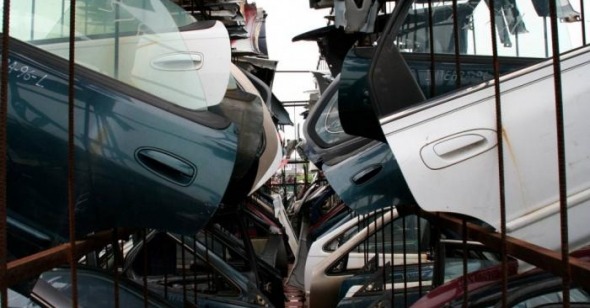Junk Art
by Adam Nayman
Foreign Parts
Dir. Verena Paravel and J.P. Sniadecki, U.S.
A deserving winner of the Best First Feature prize at this year’s Locarno International Film Festival, Verena Paravel and J.P. Sniadecki’s Foreign Parts was produced with the support of Harvard’s Sensory Ethnographic Lab—the same department that produced Lucien Castaing-Taylor and Ilisa Barbash’s Sweetgrass (Castaing-Taylor is the program’s director). There are no sheep in Foreign Parts, but its relationship to the earlier film is unmistakable: not only in the sense that Sniadecki and Paravel favor an immersive yet unobtrusive documentary style, which eschews narration or contextualization, but also in its focus on a long-standing yet vanishing professional community.
Both films are concerned with American environments, but the locations could not be more different. Sweetgrass unfolds against the expansive backdrop of Montana’s Beartooth mountains, with its jagged rocks, roaring creeks and flat sight-lines, and so even in the absence of detailed exposition, the film is easily understandable as a kind of classical Western adventure. It’s a left-to-right journey across perilous terrain. Foreign Parts, by contrast, is set in an urban space: the Willets Point neighborhood of Queens in New York, a god-and-civic-planner-forsaken patch of mud and snow dotted with chop shops (and in fact the setting for Ramin Bahrani’s 2007 drama Chop Shop).
The visual possibilities afforded by Willets Point are spectacular, in the sense that the sheer volume of rusted and degraded metal material stands (or teeters) as a kind of prefab industrial critique. If cars are the indeed most iconic of America’s mass-produced products, then Paravel and Sniadecki’s images of splayed and mutilated chassis stacked as far as the eye can see register as more than mere reportage. There’s something of Edward Burtynsky’s manufactured landscapes here, and the sequences describing the fates of these wrecked and abandoned cars are positively hypnotic: metal-on-metal violence is supremely photogenic.
But Foreign Parts is a film about people, not cars. Over the course of a two-year shoot, Paravel and Sniadecki gained the trust of the community living and working in Willets Point—a combination of immigrant and itinerant individuals. Gradually, these persons moved from being figures in a landscape to actual subjects, which is not to say that Foreign Parts actively narrativizes the lives onscreen. Quite the opposite: the filmmakers’ tactics are glancing in the best vérité tradition, permitting characters to wander in and out of the film without always establishing a clear sense of who they are and where they’re going. Some become familiar: Sarah and Luis, who live together in a van and dread the onset of winter (and the possibility that Luis will return to prison); Julia, a diminutive homeless woman oddly disconnected from any sense of misery even as her ragged person testifies to plenty of experience with same; and Joe, a lifelong Willets Point resident who functions as the community’s de-facto mouthpiece. At several points in the film (including, crucially, the final passages), Joe rages sincerely, and entertainingly, about plans to gentrify a community that has previously been ignored by municipal government—and is thus expected to be evicted without much of a fight.
Insofar as it strives to catalog specific sights, sounds, and experiences in a place that is considered to be an impediment to an institutionalized sort of progress, Foreign Parts is a political film. It turns its gaze on an environment forged not out of intention but systematized neglect, and the structuring absence is structure itself: more specifically, even a rudimentary sense of infrastructure. There’s little evidence that the city of New York cares much about Willets Point even in light of its unique status as a “destination” for citizens from other boroughs, or at least those looking to fix or augment their cars on the cheap. It’s not the least of the film’s ironies that the 39th Avenue neighborhood is dominated by a structure located just beyond its purview: Citi Field, a potent symbol of 21st Century redevelopment (it replaced Shea Stadium as the home of the Mets) and also a pretty obvious signifier of economic disparity—a literally and figuratively concrete metaphor for a two-tiered social system.
Paravel and Sniadecki resist the temptation to editorialize too much with their cameras (one lapse: a coy tableaux of ruin with the stars-and-stripes at its center). It’s all too easy to imagine a version of Foreign Parts that evinced more obvious pride in such austerity measures, or one that manipulated the footage into a hymn to hardscrabble existence. Instead, what we get is a carefully modulated exercise in directorial self-effacement—a film of obvious craft and calculation that nevertheless gives the impression of being off-the-cuff.
